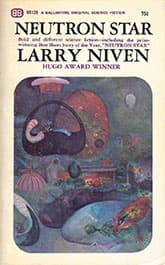Neutron Star
Critique • Quotes
 First paperback edition, 1968
First paperback edition, 1968First publication
1966, serialized in magazine Worlds of If
First book publication
1968, in collection Neutron Star
Literature form
Story
Genre
Science fiction
Writing language
English
Author's country
United States
Length
Approx. 6,500 words
A star's lost lustre
If "Neutron Star" seems like an Isaac Asimov work, it may be because Larry Niven got the idea for the story from an Asimov piece. In introductory notes to a collection of Hugo award winners, including "Neutron Star", Asimov recalls the younger writer telling him it was inspired by his article "Time and Tide", which had appeared in a magazine.
"The idea was implicit in my article," Asimov wrote, "and if I had only thought fiction-wise instead of article-wise, I might have written the story."
That may be true, as "Neutron Star" is the kind of hard science fiction—based on science fact—in which Asimov and other SF writers of his older generation excelled.
The story sets up a scientific mystery to be solved. In the distant future, a mission to travel close to a massively heavy neutron star, the first to be discovered, has ended in disaster. What force reached into the ship to kill them?
Beowulf Shaeffer, who would go on to appear in other Niven stories, is sent to investigate. And, after he is nearly killed himself, he finds the scientific solution.
Wondrous effect
The adventure is dressed up with some behind-the-scenes intrigue and some light-hearted banter. But its big appeal is the wonder elicited about the bizarre effect of a neutron story.
Of course, if Shaeffer or his bosses had read Asimov's article some centuries earlier, they would have had the explanation already, or they might have never sent human beings so close to a neutron star in the first place.
The great science popularizer Carl Sagan made a similar complaint about "Neutron Star" in 1978. How could future scientists not be aware of this effect we had known about centuries earlier?
But that's a bit unfair. Niven was writing the story for contemporary readers who likely were not aware of it yet. A wondrous reading experience was in store for them.
Still, some decades later, "Neutron Star" has lost some of its lustre. The writing hearkens back to an earlier scifi style of gee-willikers exposition and one-dimensional characterization. Even the stellar entity at the centre of the story is no longer so fascinating, having been superseded by black holes as the go-to bizarre phenomenon for science and science fiction geeks.
But, if you put aside the anachronisms and the thin characters, it's still a twenty-minute blast to read.
"Neutron Star" is also known for introducing, besides Shaeffer, the alien called a "puppeteer", a nearly invincible spaceship hull, and other features that would appear in the Known Space stories and novels of Larry Nive for years to come.
— Eric
Critique • Quotes

